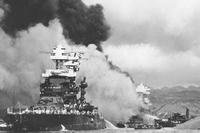Morale is important for any army or naval force. It improves unit cohesion, supports the achievements of both the individual and the group and can even be the difference between victory and defeat.
During World War II, the Allies went to great lengths to keep the spirits of their troops up as high as possible. What better way to keep the fighting men happy than with some ice-cold brews in the heat of the tropics?
There was only one problem with getting the suds to the fight: Beer doesn't travel all that well. To keep the men fresh, the Allies needed to keep the beers fresh, and the best way to do that, it turns out, is to brew the beer close to where it's being consumed, even if it's during World War II.
Beers are going to taste different as they get farther and farther from where they were first brewed. In general terms, fresh beer is always better than aged beer. The compounds that make up the flavors in beer will all be changed by how long it ages, how much light it receives and how much motion the cask goes through with the beer aging inside.
There are a lot of these kinds of factors that affect a beer's flavor profile, and all of them can be triggered by how the casks are handled during shipping. Needless to say, a trip from England or even Australia to the front lines of WWII was a long one and subjected the beer to endless problems.
Troops in the Pacific War often got beers that were subject to various temperature extremes, left in the sunlight and spent countless days in transit. As a result, their beers could turn skunky or downright terrible. It definitely would not be the taste of home Allied leaders intended to use to build morale.

In order to mitigate that problem, the British converted an already converted merchant liner to hold a brewery, so that troops could get a fresh beer, complete with the flavor they expected, when they were away from the front.
The HMS Menestheus was converted into a minelayer in the Atlantic Ocean at the beginning of World War II. It was one of many minelaying ships that helped set up the Northern Barrage, a series of oceanic minefields that stretched from the northernmost British Isles toward Iceland and into the Denmark Strait.
The idea was to restrict German access to the Atlantic while forcing their ships through specific routes. The mines were set by the end of 1942, so the HMS Menestheus was converted once more to an amenities ship and sent to the Pacific Front.
By 1944, the Menestheus featured a movie theater and canteen, as well as a complete beer brewery. Its hull was converted to include a 55-barrel brewing pot, powered by the ship's own boiler, and included six large fermentation tanks. It was capable of brewing 250 barrels of beer every week.
The Menestheus arrived in the Pacific theater in time to finish its first batch on the last day of World War II, but the Allied occupation of Japan meant that its services were still very much required, even if the men weren't exactly fighting anymore.
Menestheus' mission was a complete success, with Allied soldiers reporting that the brews from the amenities ship were far and away better than anything they'd drunk previously during the war.
-- Blake Stilwell can be reached at blake.stilwell@military.com. He can also be found on Twitter @blakestilwell or on Facebook.
Want to Learn More About Military Life?
Whether you're thinking of joining the military, looking for post-military careers or keeping up with military life and benefits, Military.com has you covered. Subscribe to Military.com to have military news, updates and resources delivered directly to your inbox.
















